Laser Welding vs Traditional Welding: Which Is Better for Industrial Production?
Introduction
In modern industrial production, welding technology is a key part of the manufacturing process. With the development of electronics, automotive, and medical device industries, production efficiency, weld quality, and material adaptability have become critical considerations. Compared with traditional welding machines, laser welding machines offer high precision, high efficiency, and minimal heat-affected zones, making them increasingly popular in industrial production. This article compares laser welding and traditional welding across technology, cost, and application scenarios to help companies choose the most suitable welding method.
Overview of Welding Technologies
Traditional Welding Techniques
Traditional welding methods include arc welding, gas welding, and resistance welding. They offer low equipment costs and simple operation. Traditional welding machines are suitable for thick plates or large parts, but they generate large heat-affected zones, have limited precision, and may cause deformation or stress concentration.
Key Points:
Low cost
Simple operation
Limited precision
Laser Welding Techniques
Laser welding machines, including fiber laser welding machines and handheld laser welding machines, use high-energy laser beams for non-contact welding. Laser welding provides narrow seams, minimal heat-affected zones, high welding speed, and the ability to weld small parts and complex structures, making it ideal for high-precision industrial production.
Key Advantages:
High precision welding
Minimal heat-affected zone
High efficiency
Capable of welding small parts
Key Differences Between Laser and Traditional Welding
Comparison Table
| Feature | Laser Welding | Traditional Welding |
|---|---|---|
| Welding Precision | High precision, micron-level | Limited precision |
| Heat-Affected Zone | Small | Large |
| Production Efficiency | High | Medium |
| Material Compatibility | Copper, aluminum, dissimilar metals | Mainly thick plates |
| Automation | Fully automated | Mainly manual |
| Weld Strength | High | Medium |
| Suitable Industry | Electronics, automotive, medical | General industry |
Welding Speed and Production Efficiency
Laser welding equipment enables high-speed continuous welding, especially in inline and automated production lines, significantly outperforming traditional welding machines in efficiency. Laser welding factories often use multi-station or dual-head systems to optimize production and reduce per-part processing time.
Advantages:
High-speed welding
Supports automation
Increases production capacity
Welding Precision and Quality
Devices from laser welding machine manufacturers achieve micrometer-level welding precision through precise optical control and automation, producing strong and clean seams. Traditional welding machines may result in uneven seams, spatter, and defects when welding small parts.
Advantages:
Micron-level precision
Clean weld appearance
High weld strength
Material Compatibility
Laser welding can weld various metals and dissimilar materials, including copper, aluminum, stainless steel, and thin sheets. Laser spot welding machines perform excellently in battery tabs and electronic components. Traditional welding is limited by material thermal conductivity and thickness, making thin or highly conductive materials difficult to weld.
Advantages:
Can weld dissimilar materials
Stable welding for thin sheets
Wide material applicability
Heat-Affected Zone and Structural Integrity
Laser welding machines produce minimal heat-affected zones, with small and uniform weld areas, reducing deformation and stress concentration, suitable for precision components. Traditional welding machines generate more heat, potentially causing cracks or warping around the weld.
Advantages:
Minimal heat-affected zone
Maintains structural integrity
Reduces deformation
Cost Analysis
Initial Investment and Equipment Cost
Laser welding equipment has higher upfront costs, but laser welding manufacturers provide automated solutions that reduce long-term labor costs. Traditional welding machines are cheaper to purchase, but limitations in efficiency and quality may increase indirect costs.
Production Cost and Maintenance
Laser welding machines require minimal maintenance, have low consumables, and low energy consumption. In the long run, the per-part cost is lower than traditional welding machines. Traditional welding requires regular replacement of electrodes, wires, or shielding gas, with higher maintenance and labor costs.
Advantages of Laser Welding in Industrial Production
Key Advantages:
High-precision, high-strength welding
Supports automated production
Energy-saving and eco-friendly
Can weld complex structures
Can weld thin sheets and dissimilar metals
Suitable for electronics, automotive, and medical devices
Application Cases
Electronics Industry
Laser spot welding machines are used for battery tabs, PCBs, and electronic components, ensuring high precision and stable welding for small parts.
Automotive Manufacturing
Laser welding machines are applied in automotive exhaust systems, body thin plates, and sensors, offering high efficiency and strong welds.
Medical Device Production
Laser welding equipment can weld stainless steel, titanium alloys, and miniature medical parts, ensuring weld quality in a clean environment.
Scenarios Where Traditional Welding Is Still Suitable
Thick plate or large part welding
Low-cost, small-batch production
Applications where weld appearance and micro-precision are not critical
Recommendations for Choosing Welding Technology
Choosing welding technology depends on material, thickness, production volume, precision, and budget. For high-precision, small parts, or automated production, equipment from laser welding machine manufacturers is recommended. Traditional welding suits thick plates and low-cost requirements.
Conclusion
Laser welding machines outperform traditional welding machines in industrial production in terms of precision, efficiency, minimal heat-affected zones, and automation, especially for electronics, automotive, and medical device industries. Companies can select the most suitable welding method based on cost, efficiency, and welding quality.
111-1024x458.png)


